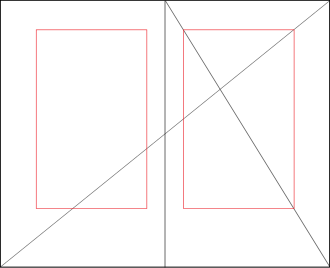Text, Image and Typography Part 3: Research task 1 The Golden Section
Research take aways...
The Golden Section, or Golden Mean, has been applied by artists and designers over the centuries to create harmonious formats for their work. In his extensive research, Tschichold discovered that many book designs were based on the Golden Section. Based on a mathematical formula, and directly linked to the Fibonacci series, the Golden Section provides a method of creating and dividing space that is a useful working framework for the book designer.
“Some books use no grid system at all; children’s books and fine art catalogues often don’t use a grid system, as the illustrations themselves predetermine the form the page will take. By contrast, the use of grids in newspapers and magazines is visually very evident.”
I read the Wikipedia page about the golden section and took paragraphs about what it is and what the purpose is.
Canons of page construction - Wikipedia
“The canons of page construction are historical reconstructions, based on careful measurement of extant books and what is known of the mathematics and engineering methods of the time, of manuscript-framework methods that may have been used in Medieval- or Renaissance-era book design to divide a page into pleasing proportions.”
“This construction of book pages was popularised by Jan Tschichold based on the work of J. A. van de Graaf, Raúl Rosarivo, Hans Kayser, and others.”
The geometrical solution of the construction of Van de Graaf's canon, which works for any page width:height ratio, enables the book designer to position the type area in a specific area of the page.
So this golden canon was interpretated differently by different designers…
Van de Graaf devised this construction to show how Gutenberg and others may have divided their page to achieve margins of one-ninth and two-ninths and a type area in the same proportions as the page.
Tschichold's "golden canon of page construction" here illustrated by a synthesis of Tschichold's figure thereof, with the diagonals and circle, combined with Rosarivo's construction by division of the page into ninths. These two constructions rely on the 2:3 page ratio to give a type area height equal to page width as demonstrated by the circle, and result in margin proportions 2:3:4:6 (inner:top:outer:bottom). For other page ratios, Rosarivo's method of ninths is equivalent to van de Graaf's canon, as Tschichold observed.
Medieval manuscript framework according to Tschichold, in which a type area proportioned near the golden ratio is constructed. "Page proportion is 2:3, type area proportioned in the Golden Section.
Tschichold's drawing of an octavo-format page proportioned in the golden ratio. The type area and margin proportions are determined by the starting page proportions.
Because this is all quoted and for my to refer to as an more readble definition of the full article this page is all reference material.
Wikipedia. (2020). Canons of page construction. [online] Available at: https://en.wikipedia.org/wiki/Canons_of_page_construction.
To understand it a bit more I looked for some videos on youtube so I could watch someone explain it in a way visually where I could use it in the future.
This video had a great explanation and he even shows you how to use it to create a logo in illustrator usinge the Golden ration circles.
https://www.youtube.com/watch?v=CSoHCHQ3zJw
Wikipedia. (2020). Canons of page construction. [online] Available at: https://en.wikipedia.org/wiki/Canons_of_page_construction.
Wikipedia. (2020). Canons of page construction. [online] Available at: https://en.wikipedia.org/wiki/Canons_of_page_construction.




.png)
.png)
.png)
.png)


.png)




Comments
Post a Comment